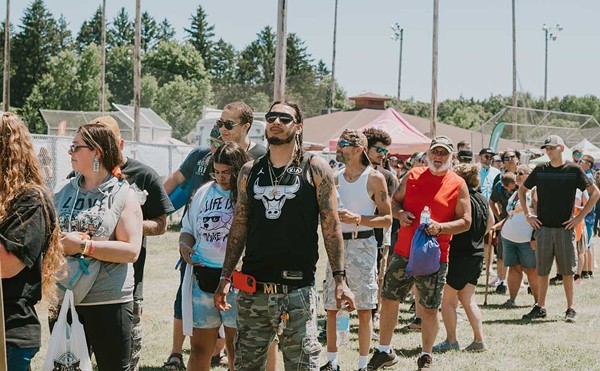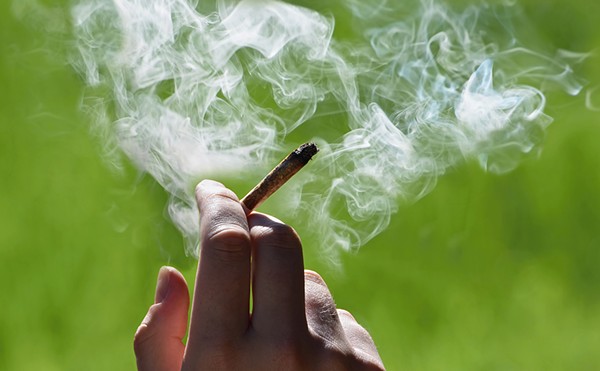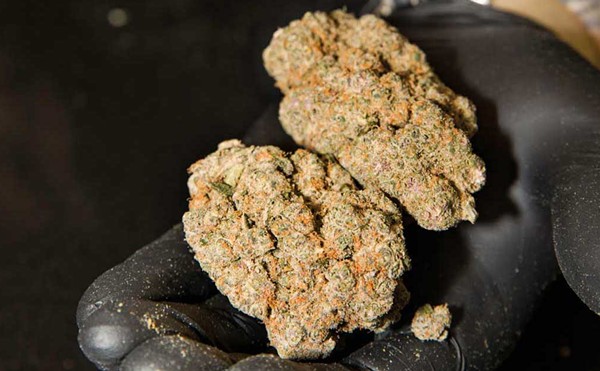What is the most powerful marijuana?
Well, that's a very interesting question. A lot of people in the world of weed are always on the lookout for the most potent stuff in order to get the most euphoric high. Not all of them all the time — but everybody who enjoys a high wants to be taken higher every once in awhile.
That usually means seeking the highest percentage of THC in your buds. Which is why there is so much high-THC stuff around. For a long time, it was the only cannabinoid that mattered, so growers developed strains with higher and higher THC content because that's what the market demanded.
A guy at the recent THC Festival told me that he prefers a strain named Gorilla Glue because "it will make you have a panic attack. It's really potent."
A strain named Gorilla Glue No. 4 was on a list of top strains for 2017 at herb.co with a THC level of 25 to 28 percent. That's pretty high.
I've seen several lists of top strains for 2017 that have little agreement with each other, except that those strains all have a high THC profile. On top of that, these lists evidence a certain poetic sensibility in naming their strains. I don't think of the name "Gorilla Glue" as poetic, although somebody probably does, but "Blue Dreams" and "Zensation" fit the bill for me.
There are probably thousands of strain names that have come and gone as amateur plant geneticists happily experiment in their basements and backyards. I knew a guy in the 1980s who developed his own handful of strains and named them after letters of the alphabet. He was the first grower that I knew (other than some guys who grew outdoors near Rochester) and, as far as I was concerned, he had the best stuff around. Since then, growing marijuana has exploded and everybody and his brother will tell you they grow better stuff than anybody else.
And so far I've only brought up THC. Another cannabinoid, CBD, has practically been bred out of most strains. A few years back, when folks started discovering that CBD was pretty good at helping people with epilepsy, it was pretty hard to find. That's why the Charlotte's Web strain, bred by some brothers in Colorado, was suddenly in huge demand. Now, Charlotte's Web is a trademarked cultivar that families literally travel across the country to get.
CBD plants are becoming more common as plant geneticists do their thing for the new market. CBD doesn't produce a high, and several states have dipped their toes into the medical marijuana pool by passing CBD-only laws. In the long run, CBD and THC are only two (although the most abundant) of what may be up to 100 cannabinoids in marijuana that medical researchers are beginning to find work better as a balanced whole rather than individual substances.
For instance, take that panic attack thing the guy from the THC festival talked about. I believe that those things happen partly because THC is very high in some strains and CBD is so low. Among other things, CBD is considered to have anti-psychotic effects — sort of taking the edge off the THC so that panic thing doesn't happen.
Marinol, a synthetic THC prescribed to cancer and AIDS patients to stimulate their appetites, is known to cause anxiety in addition to other side effects including insomnia. THC alone does not give the full effect of marijuana.
"It just doesn't work," says Dr. Nina Robb, who worked at the Greenlight certification center in Troy before retiring. "Cancer patients don't like Marinol. They want the real marijuana. There are dozens of cannabinoids that work in synergy with each other — it's not just one chemical."
So medical marijuana asks a different question than recreational when it comes to the most powerful marijuana. It's more a question of what's most effective. And that can vary from condition to condition and person to person.
"It's not one size fits all, our receptors are all different," says Robb. "We're not all the same."
Then there are the other cannabinoids, such as CBC, CBN, CBG, etc., and they are all being found to have their own effects, or to have a moderating hand in the effects of THC or CBD. CBG is being looked at as a possible treatment for psoriasis.
OK, enough of the alphabet soup. Most likely it's going to be a while before any significant amount of attention goes toward them.
Another level of effects come from the terpenes, which are aromatic oils that give the various strains their distinctive aromas. When you think terpenes, think aromatherapy. These oils might smell piney, citrusy, musky, or like lavender, and are beginning to be understood as contributing to the synergy of effects.
But all of this strain business could soon be moot because of extracts and concentrates. What does it matter how strong a specific strain is when anybody who wants to can make some sort of extract or concentrate to create something with THC levels well beyond what naturally occurs in the plant? Of course, that stuff costs more: The rule of thumb in marijuana has always been the higher the THC level, the higher the price. And the very act of concentrating it in dabs, wax, hash, kief, and oils make them cost even more.
Go into a provisioning center or dispensary and you'll find that higher THC stuff costs more. What you like may be tempered by what you can afford — although if you can grow your own, then you can get the strain you want and grow it to your heart's content.
But let's get serious about what is the strongest stuff out there. I looked at eight lists of the strongest or most popular kinds of strains. None of them were even remotely close to each other. However, one strain did show up on six of the lists: Durban Poison. DP, a sativa, originated in South Africa and is a worldwide favorite these days. Reports show that it fluctuates between 19 and 24 percent THC, with some samples having even higher amounts.
Another strain, OG Kush, showed up on four of the eight lists. OG Kush is the root cultivar of much of the West Coast marijuana crop. It's a sativa with 19 percent to 26 percent THC, and less than one percent CBD.
There are plenty of other strains out there, but these were the two that were more consistently mentioned than others.
The search for the most powerful, potent, or effective marijuana will continue for the foreseeable future. And it will be continued in the laboratories and medical facilities, in addition to the basements of home growers.
Keep searching.
The Canadians have finally rolled out their bill to legalize recreational marijuana from sea to shining sea north of the U.S. border. The skinny is that starting in mid-2018, Canadian government regulated (and taxed) marijuana will be available for adults 18 and older. Adults will be allowed to have up to 30 grams in public and have up to four plants at home. While that is happening just across the border in Windsor, it will definitely be illegal to bring it to the U.S.






